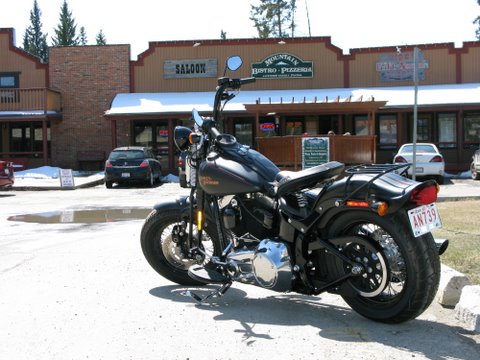Inside Motorcycles, 1954 BMW R25/3, by Greg Williams
Story first published in Inside Motorcycles, July/August 2009
Click the thumbnail to enlarge.
All photographs courtesy Amee Reehal
Story first published in Inside Motorcycles, July/August 2009
Click the thumbnail to enlarge.
All photographs courtesy Amee Reehal
I have no idea what this scooter is — old black and white photo found in an archive. Machine is pictured in front of a Harley-Davidson dealership. Look closely and you can see tricycles and bicycles in the store. Pretty sure it’s not a Harley-Davidson. UPDATE: Click on the comment above to learn more about this unique scooter, or read the magazine story provided by Barry Brown — thanks Barry. Pretty amazing story. (From a 1935 edition of MotorCyclist.)
But check out the Honda DN-01. A very modern and updated version?
Photo courtesy Honda Media.
Millarville is just a few minutes south of Calgary, Alberta. This swap meet usually draws vendors with real parts, not a bunch of leather and bandanas. You owe it to yourself to come and check it out.
NOTE: UPDATE for 2010 — EVENT is on Sept. 12. Same times and contact info. See you there.
Click on the poster for more details, and check http://calgarythursdaybikenight.wordpress.com
Or, click on this other poster for a map to the Millarville Race Track location.
Photos by Greg Williams
Top photo: Don Siewert on the left, Ted Allan on the right. If memory serves, these photos were taken in the fall of 2002 after the North of 49 returned from Bonneville.
This story first published in the Calgary Herald Driving section Friday, July 10, 2009
Everyone has something they love to do.
But it’s not very often that we are lucky enough that our passion and our life’s work are the same.
Calgarian Don Siewert is one of the lucky ones. Hotrodding has long been Siewert’s obsession, and just about everything he has ever done has given him the skills necessary to build cars.
Now, Siewert is being recognized for his passion. When he opened his mail last week Siewert, 74, was overwhelmed at news he will be inducted into the Canadian Street Rodding Hall of Fame (CSRHoF).
“This is something that I never thought would happen,” Siewert said during a telephone interview from his home in southwest Calgary. “You just do what you’re doing, and life kind of goes on. But this award does elevate you, and makes you realize life is very good.”
Siewert was born on a farm just north of Drumheller. At 17 he wanted to drop out of school but his parents insisted he get an education. After graduation he enrolled at SAIT in what was called the Farm Construction program – Siewert said this related to all of the machinery found on the farm.
At much the same time Siewert was looking for a set of wheels. He was 18 or 19 when the first car he had, a 1933 Chev coupe, blew its motor. A 1935 Ford truck was his next vehicle. The first thing he did was yank out the original 60 horsepower, 136 cubic inch Ford motor and install a 110 h.p. 255 cubic inch Mercury engine.
“I had a hotrod,” Siewert said, and laughed. “That little Ford truck was the indoctrination.”
The Farm Construction program gave Siewert time towards his apprenticeship, and at 20 he left SAIT with his journeyman ticket as a licensed mechanic. That led him to a job at Currie Barracks, where he could quickly grind a set of valves on a Bren gun carrier – not an easy task.
From servicing engines Siewert moved on to autobody work, and he eventually received his ticket in that field. He then worked for the City of Calgary as a vehicle painter for two years. Next, he became an insurance damage appraiser, and then he worked again as a painter, but this time he finished wooden desks and furniture.
“That kind of rounded out my trade career,” Siewert said.
He used to rent a garage in Sunalta where he built hotrods and lead sleds. Now he has his own double car garage as a workshop, and he has even performed some restorations. In fact, he went from building hotrods to restoring some Ford Model As and Ts to bone stock original. Siewert also restored more than a dozen early Mustangs.
“I’ve always had the hotrodder instinct, but I like my old original stuff, too,” Siewert said. “I’m not content with buying pieces and putting them on a car, I’m content handcrafting pieces that are made to fit, and there’s a lot to be said about that. I like to have my signature on a car in the parts that I build.”
He turned hotroddng into a family affair. Siewert has built cars with his sons, and now the grandchildren are getting involved – especially now that he has been racing with the North of 49 Bonneville team (www.1149.ca). The Bonneville Salt Flats are legendary in hotrodding circles – the flats offer a venue where a builder can find out just how fast the car or motorcycle they have built will really go.
“At the Foothills Street Rod Association meetings a fellow would talk about Bonneville,” Siewert said. “I said I don’t even want to go down and look, because I knew I would be hooked if I saw the flats.”
Siewert once read about Bonneville in a 1950s Hot Rod magazine article.
“I never forgot about reading about the salt,” Siewert said. “So, in 1998 I went and looked. It’s such a self-rewarding sport, everything is measured by your ability to build, and I fell in love with the idea and decided maybe I should try and create a salt flat racer.”
He realized he couldn’t do this by himself, so in 2001 he took Ted Allan of Allan Rod & Custom down to Bonneville – and the salt bug bit Allan.
“I had a 1928 Ford Model A truck body, and we hit everybody we could hit for parts,” Siewert recalled. “A great group of friends wanted to be a part of this, and they became committed to helping us out.”
A race truck was fabricated in less than a year, and the team raced in 2002 and learned some valuable lessons. While they didn’t break 200 mph, they came close, and when they got home they regrouped.
The truck that the North of 49 team built currently features a 427 cubic inch Chev engine capable of pulling 840 h.p. Backing up the engine is a 350 Chev automatic transmission. In 2007 at Bonneville Siewert piloted the truck to its fastest recorded speed of 210.5 mph.
Each year the team has raced at Bonneville Siewert has driven his 1930 Ford Model A Roadster hotrod down to the event.
“We drive it in the rain, it’s no big deal for us,” Siewert said. “Bonneville, for me, was all about driving down to Utah in the Roadster, being on the salt, and driving the race truck. And, for us Bonneville was a family affair.”
For the last 10 years Siewert has also shared his passion with students as a teaching assistant in high school auto shops.
In early October Siewert heads to Waterdown, Ontario to collect his accolade.
According to the CSRHoF website (www.csrhof.com/index.html) the Hall of Fame has existed since 1993, “To help guide the future of street rodding by recognizing the individuals, groups and corporations who have made a significant contribution in the past to the development of the hobby in Canada on a local, regional or national basis.”
Siewert said: “It’s really quite an honour.”
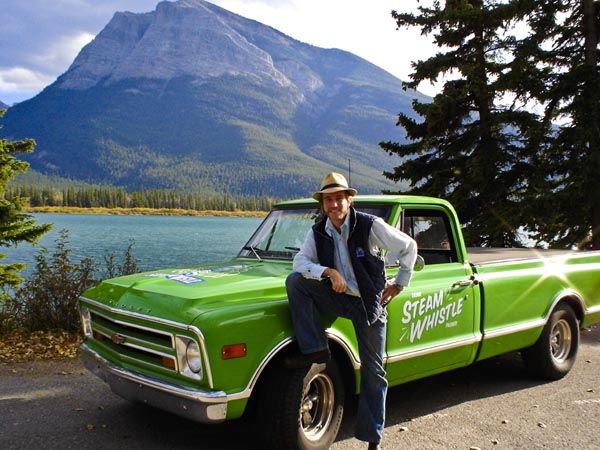 Photo courtesy Steam Whistle Brewing. This story first ran in the Calgary Herald’s Driving section on Friday, June 26.
Photo courtesy Steam Whistle Brewing. This story first ran in the Calgary Herald’s Driving section on Friday, June 26.
Nothing causes heads to turn quite like a classic vehicle rolling down the street.
Paint it bright green and slap your company name on the side, and you’ve got the ideal rolling promotion campaign.
At least, that’s what the folks at Steam Whistle Brewing have learned.
“We acquired our first vintage vehicle shortly after we opened the business,” explains Greg Taylor, 45, Steam Whistle co-founder. “It was a 1949 International stake-side truck. And it was effective at making people smile.”
In 2000 Steam Whistle Brewing got its start in Toronto. The founders, Taylor, Cam Heaps and Greg Cromwell had all worked at the same microbrewery in the 1990s. They soon found themselves out of work when a big-name brewing company bought out the business. Sitting around the campfire while on a canoe trip they started talking about owning their own brew company – and brewing one really good beer.
And that brewery is Steam Whistle.
There’s a distinctly vintage feel about the entire company. The Pilsner beer is brewed in the old John St. Canadian Pacific Railway roundhouse in Toronto, and even the name is a throwback to a time when the blast of a steam whistle signaled the end of a workday.
And then there is Steam Whistle’s fleet of vintage vehicles.
There are eight old trucks and buses, all of them used on a daily basis to deliver Steam Whistle product to pubs and stores.
“Vintage vehicles represent our brand on the road,” Taylor says from his Toronto office. “The vehicles represent a simpler time and an age of innocence.”
There is a western connection to the Steam Whistle story. In 2005, Steam Whistle salesman Brad Goddard picked up a freshly restored and painted 1968 Chevy half-ton truck. With his twin brother, two suitcases and a few cases of beer, he drove the truck to Calgary.
“We picked up the truck from the body shop and drove straight to Calgary,” Goddard says. “It took us about three and a half days, and when we got here I had no idea where I was going to live. I stayed at the Sandman Hotel for a month and a half.
“I’ll never forget seeing the north end of Lake Superior, and the landscape at the border between Saskatchewan and Alberta.”
When he got his ‘company truck’ to Alberta one of the first things he did was obtain an Alberta plate. To do so, he had to get an Out of Province inspection. None of the mechanics he took the truck to felt comfortable performing the inspection – simply because the vehicle was so old.
That is, until he found a mechanic at Kirkham Automotive in southwest Calgary who knows the old Chevy and GMC trucks like the back of his hand.
“He was comfortable looking over the truck, and signing his name on the inspection certificate,” Goddard says.
All of the Steam Whistle vehicles – a fleet that consists of trucks, vans and buses — have a nickname. Goddard’s truck is called Betty – named in honour of Liz Fitzgerald, one of the company’s female brewers. Apparently, there are very few female brewers, and Fitzgerald is one of a handful in North America.
The other vehicles all have a nickname that describes one of their traits or a part of their personality. For instance, there is Lumpy, the 1949 International ¾ ton truck, who rides a little rough with his stiff suspension. Then there’s Shakey, a 1951 Chevrolet sedan delivery, so named because when Taylor bought the vehicle and drove it the five hours home it vibrated so much he woke up the next morning with a sore back.
The vintage fleet has all been restored, and Taylor says most of the trucks have newer engines and features such as power steering and power brakes.
“Some of them also have improved seating, and we’ve installed seat belts in them, too,” Taylor says. “We need these vehicles to run on a daily basis and not have them in a shop all of the time.”
Keeping Betty on the road in Calgary costs the company about $1,500 every six months, and the truck sees some 15,000 kilometres added to the odometer each year.
Goddard drives Betty year round, and the truck is used as a delivery vehicle and promotional tool. While parked at a recent Calgary Beer Fest some pranksters were seen dumping a bottle of beer into Betty’s gas tank.
“She hiccupped a bit, but the beer just blew right through her,” Goddard laughs.
Betty is equipped with a rebuilt 350 cubic inch engine, and Goddard says: “She’s not a show vehicle – she looks a bit Frankenstein underneath. Betty looks pretty, but she is a working truck.
“In the winter it’s not very warm, and in the summer it’s not very cool,” Goddard says of the driving experience, and adds, “The only way you stay cool is believing you look cool driving the truck.”
Steam Whistle’s Taylor says he finds the vintage vehicles through online auctions, and others are offered to the company from private owners. He’d like a vehicle from each decade, something that might speak to both young and old.
“What’s retro to one person might be recent for someone else,” Taylor says. “Some kids are calling early 1990s music retro, and I’m saying, ‘What?’”
Taylor is currently looking for a late 1970s or early 1980s full size van – one that would have had the ladder up the back door and a mural on each side.
“I’m interested in covering all demographics with our vintage fleet,” Taylor says.
Photo courtesy Steam Whistle Brewing.
The City of Calgary has offered cyclists and scooterists a whopping break in the fee to park a powered two-wheeler in six select downtown designations.
How much of a whopping break? It still costs $2.50 per hour.
But that doesn’t go far enough.
Calgary, like that city in the east, Toronto, should encourage two wheelers to roll downtown — and park for free.
Come on, sign this petition. Show some initiative here.
And no, it’s not my petition. I just think it’s a good idea.
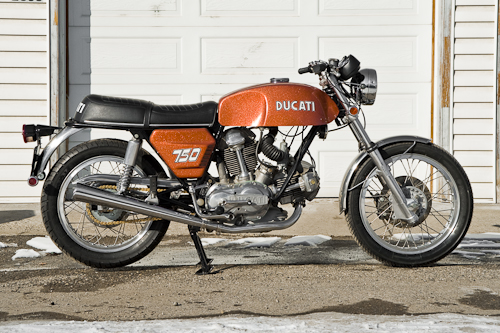 All photos are courtesy Amee Reehal. This story and photos first published in Inside Motorcycles, Issue 12/02
All photos are courtesy Amee Reehal. This story and photos first published in Inside Motorcycles, Issue 12/02
Some motorcycles represent the pinnacle of development, and mark a distinct moment in a brand’s history. For Ducati, such a seminal machine is the 750 GT.
From the end of the Second World War until the 1960s Ducati was famous for producing small bore, single cylinder motorcycles — including the Scrambler and Mach 1 models. But by the end of the 1960s the motorcycle world had introduced to a market hungry for displacement larger, multi-cylinder machinery. BSA/Triumph had their Rocket 3 and Trident (respectively) triple-cylinder motorcycles on the market in 1968, and Honda introduced its four-cylinder CB750 in 1969. To be competitive in the lucrative North American big-bore market Ducati needed something larger than a 450cc single.
And it came with a design from Ducati’s maestro, the famous Fabio Taglioni, or Dr. T as he is often called. He drew a new 750cc 90-degree V-twin with bevel-gear drive overhead cams. The wide angle between the cylinders gives the motor an ‘L’ appearance, and in the tube frame the engine becomes a stressed member. The front, or lower cylinder is almost horizontal, while the rear or top cylinder is in a near vertical plane.
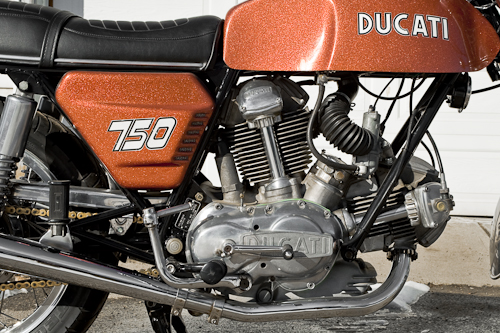 First introduced at the Olympia motorcycle show in London in 1971 the Ducati 750 GT immediately made a splash. It took a long time to fill orders, though, because the first 404 sand cast case motors were built entirely by hand. It took Ducati mechanics 40 hours to completely assemble a motor and set up the bevel-gear drive.
First introduced at the Olympia motorcycle show in London in 1971 the Ducati 750 GT immediately made a splash. It took a long time to fill orders, though, because the first 404 sand cast case motors were built entirely by hand. It took Ducati mechanics 40 hours to completely assemble a motor and set up the bevel-gear drive.
Fred Johansen was born in Holland and moved to Canada when he was just six. Johansen spent his formative years in Calgary, and has been obsessed with motorcycles from an early age. In the late 1960s when he was in grade 11 he bought a Suzuki 250 Hustler. His group of motorcycling friends was getting larger and more sophisticated machines as time progressed, and his friend Glen Parsons bought a 1972 Ducati 750 GT brand new from Fairview Cycle in Calgary for some $2,100.
“That Ducati was Glen’s daily rider and he treated it like any other piece of equipment, and it suffered a bit from lack of maintenance,” Johansen says. By 1978 there were some issues that needed to be addressed, and the motor was removed from the frame, the heads disassembled, and then put in boxes and stored in his mother’s basement. The rest of the rolling chassis was left exposed out in the backyard.
Johansen, a home renovator, eventually lost touch with his friend. “But one day, out of the blue, Glen called to ask if I was still doing construction,” Johansen says. “He wanted some work done on his mom’s house. While I was doing that work I discovered the rolling chassis of the Ducati. The funky metal flake gel coat Fiberglass gas tank had faded to silver on the top, and I said “We have to do something with this bike.” This was in the early 1990s, and the pair dragged the Ducati to Johansen’s then newly built three-car garage. Here, they each focused on their separate motorcycle projects. Johansen was rebuilding a 1972 Suzuki Water Buffalo at the time.
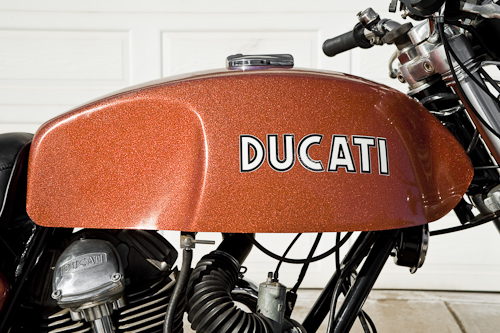 Work on the Ducati progressed slowly, and somewhat sporadically. Unfortunately, Parsons was diagnosed with MS in the late 1990s, and the Ducati project got put on the back burner. “He was feeling badly about leaving his bike behind in my garage and not dealing with it,” Johansen says. “I told him to just deal with what you have to deal with — the bike’s fine where it is.”
Work on the Ducati progressed slowly, and somewhat sporadically. Unfortunately, Parsons was diagnosed with MS in the late 1990s, and the Ducati project got put on the back burner. “He was feeling badly about leaving his bike behind in my garage and not dealing with it,” Johansen says. “I told him to just deal with what you have to deal with — the bike’s fine where it is.”
Just a few weeks later and Parsons had signed over ownership of the Ducati to Johansen. “‘Rather than waiting for this’, he said, ‘you might as well own it now,'” Johansen recalls. “Needless to say, that bike’s the only one in my stable that will go to the grave with me, I’ll never sell it.”
Turns out Johansen’s 1972 Ducati 750 GT was the sixth in Canada, and only the second in Alberta. The first 750 GT was built in June 1971, and Johansen’s was built on January 17, 1972. There were only 404 sand cast crankcase motors built, and Johansen’s machine was put together about three-quarters of the way through early production.
In February 1972 Ducati prepared eight 750cc race bikes to compete in the Imola 200 in Italy — an event where Ducati racers Paul Smart and Bruno Spaggiari placed first and second. Now, this win cemented Ducati’s place in the large-displacement motorcycle fraternity, and demand for the 750 GT increased exponentially. Ducati were forced to change their production methods as the company attempted to keep pace with demand, and the engine cases were no longer sand cast items.
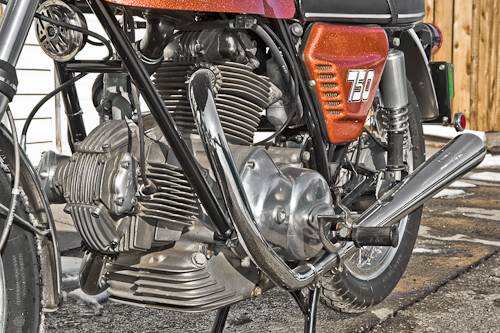 Soon after he took ownership of the Ducati Johansen began collecting the various parts he’d need to put the 750 GT back together. He acquired new pistons, rings, pins and gaskets, and a brake rebuild kit for the front Lockheed hydraulic disc. Johansen also purchased a set of the newly reproduced Conti mufflers as the originals had long since rotted away. While the orange Fiberglass gas tank had faded to silver, an experienced auto body man hand rubbed the finish and brought back the colour to about 85 per cent of its original sheen. He put two coats of clear over the tank, and that’s the way it sits — as close as possible to the original Ducati orange. The frame was restored with a fresh coat of paint. Wheels, which are flanged Borrani rims, were laced back together with stainless steel spokes and new Metzeler tires went on front and rear.
Soon after he took ownership of the Ducati Johansen began collecting the various parts he’d need to put the 750 GT back together. He acquired new pistons, rings, pins and gaskets, and a brake rebuild kit for the front Lockheed hydraulic disc. Johansen also purchased a set of the newly reproduced Conti mufflers as the originals had long since rotted away. While the orange Fiberglass gas tank had faded to silver, an experienced auto body man hand rubbed the finish and brought back the colour to about 85 per cent of its original sheen. He put two coats of clear over the tank, and that’s the way it sits — as close as possible to the original Ducati orange. The frame was restored with a fresh coat of paint. Wheels, which are flanged Borrani rims, were laced back together with stainless steel spokes and new Metzeler tires went on front and rear.
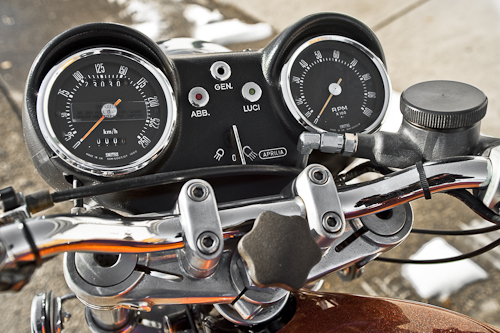 The push to get the 750 GT completely back together came when a local Ducati retailer wanted to borrow the bike when they launched the new Sport Classic Ducati series at a downtown art gallery. Johansen assembled the rolling chassis, and put the motor together loosely. He still has to pay some attention to the condition of the cams and followers, which are scored probably due to oil starvation, and he hopes to have the machine running again this year. “I’m not the least bit interested in interesting paperweights,” Johansen says of his motorcycles, a collection that includes Suzuki GT750s, rotary RE5s, and three more Ducatis.
The push to get the 750 GT completely back together came when a local Ducati retailer wanted to borrow the bike when they launched the new Sport Classic Ducati series at a downtown art gallery. Johansen assembled the rolling chassis, and put the motor together loosely. He still has to pay some attention to the condition of the cams and followers, which are scored probably due to oil starvation, and he hopes to have the machine running again this year. “I’m not the least bit interested in interesting paperweights,” Johansen says of his motorcycles, a collection that includes Suzuki GT750s, rotary RE5s, and three more Ducatis.
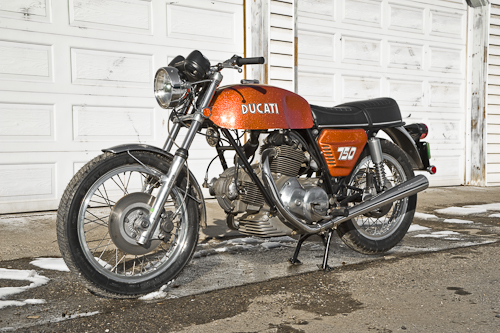
This feature first appeared in Canada’s Inside Motorycles, April 2009.
All photographs are courtesy Amee Reehal.
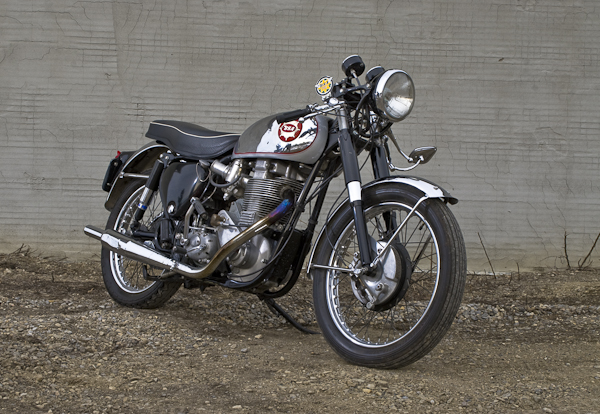
In its heyday Britain’s motorcycle industry was famous for producing single cylinder machines.
Every major maker, from B.S.A. to Velocette, offered a single in its range. Some of the big, powerful singles were simple workaday machines, and often pulled a sidecar. Others, however, were built for more lively action. Such is the case with the B.S.A. Gold Star.
B.S.A. named their Gold Star after the star-shaped gold metal badge awarded to racers who lapped Brooklands track at speeds faster than 100 mph. In 1937 racer Wal Handley took a B.S.A. Empire Star to a 107.5 mph lap — and B.S.A. decided to take advantage of the marketing opportunity.
Manufactured between 1938 and 1963 the Gold Star was available with either a 350cc or a 500cc power plant. Each engine was assembled by hand, and it was an impressive-looking all-alloy motor with overhead valves. Each unit was tested on a dynamometer before dispatch, and a Gold Star buyer was given the printed results so they were aware of their machine’s full horsepower potential (around 38 h.p. for the 1958 machine featured here). That was quite a figure back then, and the Gold Star would have been today’s Suzuki Hayabusa or Honda CBR1000RR.
Gold Star models are recognizable by their alphanumeric designations. There were only 500 Gold Stars built in 1938 and 1939, and production didn’t pick up post-War until 1949. Gold Stars built from 1949 to 1952 were ZB32GS (the 32 denotes the 350cc version) and ZB34GS (here, the 34 denotes the 500cc ‘cycle). In ’53 they were prefixed BB (as in, BB32 or BB34GS). An improvement in handling was gained that year when the frame became fully suspended, with a swingarm and twin rear shocks. Then, in 1954, there was the CB, and in 1955 the DB series debuted. A redesigned cylinder head was introduced in 1956, and after that all Gold Stars were either DBD32GS or DBD34GS. Among Gold Star enthusiasts, it is the DBD models that generate the most interest.
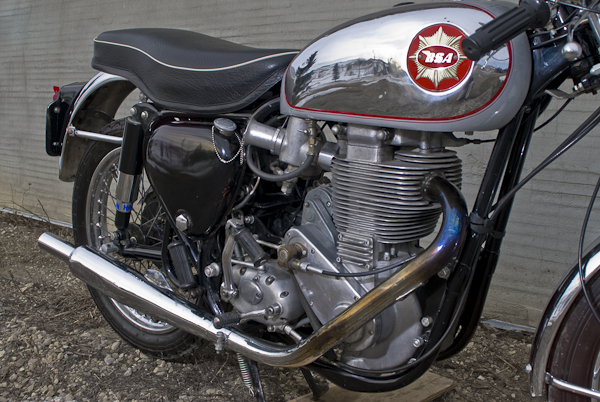
Calgary motorcyclist and collector Charles Bruce almost lost interest in two-wheelers after his first adventure in riding. He says he wanted to look cool with a leather jacket and a motorcycle, so Bruce and a friend went half on an ex-Army surplus Harley-Davidson 45. The machine had a suicide clutch and a hand shift, and Bruce didn’t like the ride. But he was willing to give motorcycles a second chance, and in 1967 he’d been working in Nakusp, B.C., when he saw a motorcycle shop in nearby Castlegaar was auctioning off some machines. He had an entire month’s pay — $300 — in his pocket and went to buy a Honda 305 Scrambler. It sold for more than $300, and that’s when a tired looking 500cc B.S.A. rolled onto the auction block.
“I remember a kid riding a big single-cylinder bike up Centre Street hill (in Calgary), and always loved the sound that bike made,” Bruce says. “So when the B.S.A. came up, I thought that might be neat.”
So, he bid, and for $275 he was the owner of what was titled as a 1961 B.S.A. DBD34GS Gold Star. Later, Bruce learned the Gold Star was a 1958 model, and had probably been raced for three years before being titled for road use. The bike was missing the left hand foot peg, and had 10″ apehanger handlebars and a red-painted light bulb for a taillight. With the $25 Bruce had left over he bought a cat-face tail light lens to cover the bulb, ordered a foot peg and a set of low handlebars. He did manage to ride the B.S.A. home that day, where he took it apart and waited for the parts to arrive. One week later, he collected his pieces and put the Gold Star back on the road. Bruce rode the motorcycle for the rest of 1967 and into 1968, but after that the bike was parked and taken to pieces.

He sent the motor to Nicholson Bros. Motorcycles in Saskatoon where the bottom end was rebuilt, and the head was worked over. Once Bruce got the motor back he didn’t go much further with the Gold Star. In fact, in 1985, he sold the Gold Star to a friend. During this time a number of parts were sourced including a larger four-gallon gas tank to replace the original two-gallon unit, and the special rear set footrests were found. Before any major work was completed, however, Bruce’s friend wanted to sell the Gold Star.
“My wife thought I was having an affair, I was so distraught about the Gold Star being sold,” Bruce says. “She said I was moody and wasn’t talking much.” So in 1987 he bought the Gold Star back, and for the second time put the machine on the road. Now in clubman trim, the Gold Star features the rear set foot pegs and the low, clip on handlebars that give the motorcycle its racing stance.
A special Eddie Dow (Dow was a U.K. Gold Star guru) 8″ twin-leading shoe front brake was sourced and installed. The machine is fitted with a racing RRT2 close-ratio gearbox, modified with a different first gear and a Triumph four-spring clutch. With the racing first gear in the ‘box, Bruce had to slip the clutch up to 50 mph just to get underway. Now, he can at least get started, but there’s a big gap between first and second gears.
Bruce researched his Gold Star through the Gold Star Owner’s Club, and they were able to confirm his engine was tested on B.S.A.’s dyno on Jan. 24, 1958, and released for sale Feb. 3, 1958. The bike went to Deeley’s in Vancouver. Bruce is almost positive the machine was a racer, as it has a special tab welded on the frame that would have held a centre mounted oil tank. That telltale tab would not have been part of a stock Gold Star frame. Gold Stars are rather famous for the muffler that is fitted, which is little more than a megaphone with a special cap welded to the end. The engine exhaust note will ‘twitter’ on the overrun.
Bruce doesn’t ride the Gold Star in the city, preferring to exercise it out on open country roads where he can back off the throttle and enjoy the tunes. Of the exhaust note, he says, “It does sound like a bird in a cage, it really does twitter.”


This review first ran in Inside Motorcycles, April 2009.

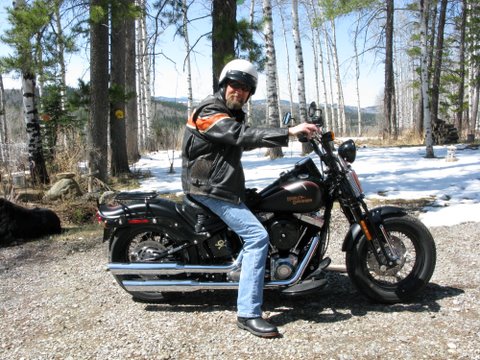
This piece first ran in the Calgary Herald’s Driving section, Friday May 15.
All photographs are courtesy Chris Crump.
Back in the 1930s and 1940s some motorcyclists would remove bits and pieces from their stock machines.
They were effectively paring away excess weight, and they’d make changes by putting on a smaller headlight, ditching the front fender and cutting or ‘bobbing’ the rear fender.
Those in the motorcycling fraternity referred to these early custom machines as ‘bobbers’.
What goes around comes around.
Ten years ago, the custom rage was for a mile-long front end, a stretched frame and a super wide rear tire. Today, bobbers have returned as the popular custom of choice. Sometimes, simpler is better.
And Harley-Davidson gets that.
Last year, the Motor Company introduced their own factory bobber, the Cross Bones, a machine that comes from their Softail family of motorcycles. The Cross Bones returns in their 2009 lineup, and we were able to get Calgary motorcycle enthusiast Chris Crump out for a daylong test ride.
Crump, 51, was born in Bermuda but raised in Regina, Sask. He bought his first brand new motorcycle in 1974, a Honda CB360 — and he worked two or three jobs to pay for the ride.
“The bike was all round transportation for me,’ Crump says. After a bad crash wrote off the CB360, Crump moved up to a Honda CB750. Since then, he’s owned several motorcycles, including many Harley-Davidson products, from Super Glides to Electra Glides.
After being bit by the road racing bug in 2000, Crump started racing Buell motorcycles on the track. Now, Crump and his Thunderracing.ca team are campaigning the new 2009 Buell XB1125.
And during the summer Crump commutes to work from Bragg Creek to Calgary, and he puts some 20,000 km on his H-D Ultra Classic touring machine. Whether it’s on the road or on the track, motorcycling has long been Crump’s passion.
 “The Cross Bones is an interesting looking motorcycle,” Crump says of his initial reaction to the ‘bobbed’ styling. “With the spring fork out front and the sprung solo seat, it looks like an old-school bike. From an uneducated point of view, you probably couldn’t tell if it was old or new.”
“The Cross Bones is an interesting looking motorcycle,” Crump says of his initial reaction to the ‘bobbed’ styling. “With the spring fork out front and the sprung solo seat, it looks like an old-school bike. From an uneducated point of view, you probably couldn’t tell if it was old or new.”
Adding to that old-style look, says Crump, is the flat black paint — a colour H-D refers to as Black Denim — and the pin striping on the gas tanks and rear fender.
Crump is not usually a fan of tall handlebars but in the case of the tillers on the Cross Bones he says they suited his 6’2″ stature.
“The bars made the riding position quite comfortable,” he says. “Its quite an upright riding position, but it felt like I was sitting on an office chair. My feet were on the floorboards and my knees were bent at 90 degrees — for me it was the perfect riding position.”
Those floorboards, together with the sprung solo saddle, are a throwback to the past. The floorboards on the Cross Bones are shaped in a half-moon configuration — a style of board Harley-Davidson was famous for on its older machines.
But the floorboards, in Crump’s opinion, were mounted either too low or too far away, as he was scraping them on corners, even in the city.
“I wasn’t riding aggressively, but even on some cloverleafs or heeled over in an intersection they’d touch down,” he says. “My (Ultra Classic) doesn’t drag like the Cross Bones did.”
However, the saddle found favour with Crump. He says it helped make for a comfortable and smooth ride.
Crump put 158 kilometres on the Cross Bones, and he started his test ride from Calgary Harley-Davidson in the northeast. He put it through its paces on the city streets, and then rode out towards Bragg Creek, and back into town along Highway 22X.
In the city is where the bike shone, he says. The 1,584cc Twin Cam engine provided good power, and Crump felt that the six-speed gearbox was the smoothest shifting item he’d ever experienced in a Harley product.
On the highway, Crump felt a full blast of wind hitting his chest, and says he probably would have been more comfortable had the bike been fitted with a windshield. Either that, he joked, or he is too old to look cool without a windshield.
He found the Cross Bones was ‘flickable’, which surprised him. Crump thought that with two big cross-section tires (front is a MT90B16, rear is a 200/55R17) the handling might be compromised, but he didn’t find that to be the case. He intentionally searched out cracks and seams in the roadway, and could not induce any wallowing or wandering. The brakes also contributed to his sense of safety.
“As a racer, I’m used to using a lot of front brake,” Crump says. “And it was quite amazing for that bike how good it worked — it was really quick to bring the speed down.”
The front brake is a single-piston caliper clamping a single rotor, and the rear brake features a two-piston caliper.
As fuel prices edge up once again, Crump thought it prudent to mention that his Cross Bones returned 4.57 L/100 km.
“That’s really great fuel economy with average riding around town and on the highway,” he says.
His final opinion of the $22,499 Cross Bones (before taxes and dealer set up fees)? Crump says, “Throw over a set of saddlebags and put on a windshield, and the bike would be a great all-rounder.”
